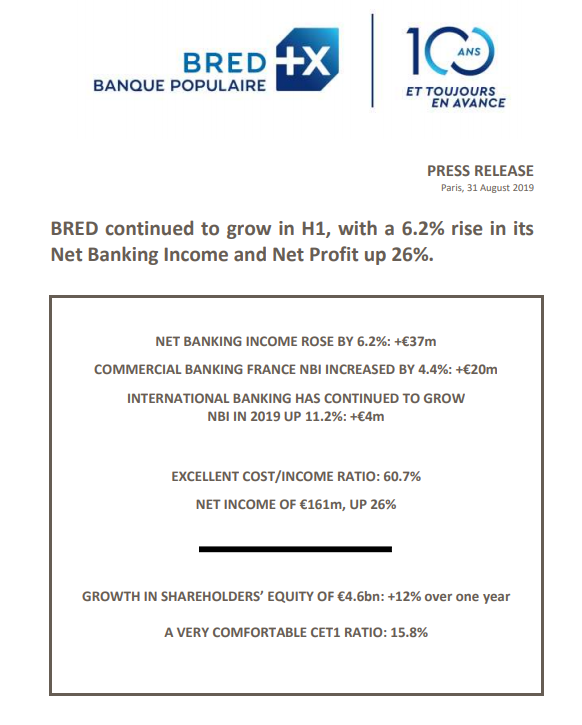Read my talk on the essential role played by regional banks given at a conference organised by IHEDATE in February 2019 on the theme of “Financial players, approaches and territories”.
Through the title “Planet finance or the financing of the real economy”, my aim is not to defend the banking system as a lobbyist but to explain the usefulness of commercial banking. And also to explain that, in France in particular, two banking models exist, each with its own interest and usefulness, though the two are not identical.
First, there are banks with a centralised model, such as BNP Paribas and Société Générale. These groups are listed on the stock market.
The other model is that of cooperative or mutualist banks, including Crédit Mutuel, Crédit Agricole and BPCE, grouping the Banques Populaires and Caisses d’Épargne. These groups have a different organisation structure, with a full-fledged bank operating in each region and territory under their brand. They also have a singular governance system. Each of these regional banks has a local board of directors or supervisory board that controls its executive. Each regional bank has its cooperative members, which hold the bank’s capital. Moreover, these regional banks are the shareholders of the central body of the cooperative and mutualist groups.
This system has regularly acquired market shares in France and delivers high-performance management ratios.
The relational, decision-making and managerial proximity of cooperative banks
What, then, are the key reasons for which the regional-bank system is developing strongly in retail banking? The reasons are quite simple.
The first is decision-making proximity. At regional banks, decisions on credit, even for the most significant amounts, are made locally, in the region. Companies also like working with banks whose decision-making centres are located in their territory.
Another key advantage to my mind is managerial proximity, which is a rather neglected point. At cooperative banks, the executives and managers have long-standing presence in the region. They contribute to explaining the bank’s strategy. The bank’s organisational decisions are also made in close connection with employees. This managerial proximity is crucial because retail banking is all about services. The ability to rally teams to the benefit of customers makes all the difference and stands as a decisive factor in making a difference in terms of results.
The third and equally essential point is relational proximity. This takes a number of forms. The relationship between the customer and the bank must be a lasting one. Our ability to properly perform our advisory business, to create loyalty and achieve profitability over the long term hinges on this relationship. In response to “low cost” banks, which recently were in the spotlight once again, BRED devised a slogan, “Banking without distance”. We can work remotely, by telephone or email, if the customer either cannot or no longer wants to visit the branch, but they can always do so if they like. And they keep their dedicated advisor. We are doing away with physical distance. But we are also doing away with relational distance, by not placing a distance between ourselves and the customer. And we seek to bring the customer added value, by providing them with the best, most appropriate advice possible. Relational proximity is also achieved through a denser network of branches. Retail banking market shares are also revealing regarding the coverage of the branch network. This is irrefutable. Relational proximity is also boosted by long-term relationships between customers and their bank.
This relational proximity can also be seen more globally. Congruence between the bank and its region and territories is essential. If we do our job well, we foster the growth of the territory. Which means that cooperative banks are in symbiosis with their territory. If the region is doing well, the bank is doing well. And vice-versa. The interests of the territory and the bank are convergent. Lastly, all regional banks are in one way or another committed socially to each territory. Some of them work in sports, others in culture, education or equal opportunities, all of which serve to improve social cohesion and the attractiveness of the territory.
And in their construction, all of these full-fledged banks are headed by entrepreneurial directors, true leaders of banking midcaps. This contributes to the performance of this type of bank.
In addition, the governance of banks, as I mentioned in my introduction, is vital. Their boards are composed of customer-members living in the same territory. The governance itself of cooperative banks is organised so as to focus not simply on customers, since it is our customers who are on our board, but also on regions and territories, since it is the customers of the region that make up the board of directors.
I would now like to talk about the economic usefulness of territorial banks. As we all know, France is a highly centralised country in terms of its decision-making processes, its ministries, and the headquarters of major groups. The system is very different in Germany, Italy, Spain and Switzerland, and in many other countries. Regional banks are important in these countries. Companies and the major decision-making centres are more evenly spread out across the country.
Regional banks as an antidote to strong centralisation in France
In France, regional banks are a possible, but real, antidote to the country’s highly centralised system.
Regional banks collect savings and grant loans in their territories. It is unthinkable to allocate savings collected in, say, Auvergne to the financing of projects in Alsace, or vice-versa, on the grounds that it would be more profitable in one than the other. This runs counter to our way of thinking, being and existing. Everyone today is championing short distribution networks; I am not sure if this a good thing or not. But whatever the case, we provide a short distribution network. And even BRED, which is present in several territories, works in this way in each one of them. We do not reallocate to the detriment of certain territories. There is no fungibility of savings in the regional banking system that could serve to move and reallocate savings to the detriment of one region and the benefit of another. It is vital to highlight and promote this system, as it serves to support and finance the fabric of SMEs in the regions.
Lastly, I would like to talk about the usefulness of traditional commercial banks, cooperative or otherwise. I say “traditional” because, while they are continuously modernising to address the expectations and needs of their customers, they continue to do the same banking business in essence, i.e. achieving correspondence, through their intermediary, between those with financing capacities (households and companies alike) and those with financing needs. This, quite simply, is working towards the financing of the real economy.
It is sometimes said that the financial markets could very well replace banks. This is an aberration, as it would result in substantial savings not being used to finance the economy. The financial markets work well for a limited number of economic players, because issuers require sufficient critical mass to achieve market listing and borrow, and because savers in their large majority lack the necessary skills to make the right choices. Furthermore, unlike banks, the financial markets do not take risks in the place of players in the real economy. The lion’s share of players with a financing capacity are unable to tap the financial markets in order to finance private individuals, professionals and SMEs because they are unable to manage their credit analysis or monitor them over time. Banks, however, are specialised in the processing of information contributing to that end. And, in a key aspect, banks support credit, liquidity and interest-rate risks on their income statement that would otherwise be borne by the lenders or the borrowers. Banks, then, serve to take risks that companies or natural persons do not want to take. Which is something that the financial markets do not do. The role of banks is thus irreducible.
To conclude, a close look at the current work, led in particular by Nicole Notat and Jean-Dominique Senard, on redefining the company and rethinking corporate governance by taking into account not just the interests of shareholders but also those of all stakeholders – employees, customers, society – demonstrates the refound modernity of cooperative banks. Through their construction – their customers being their shareholders and their representatives their board members – they are integrating into their governance itself the new direction favoured by companies. And as we have seen, they are fully contributing to local and regional finance, by taking into account the interests of the regions in which they operate.
To return to the theme of the conference, the economic momentum of territories requires local financing. Which cooperative banks provide. While they are perhaps not alone, this is their core vocation.




